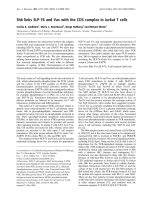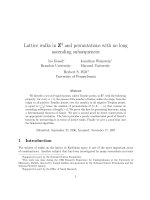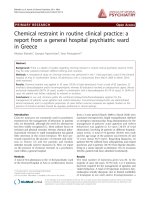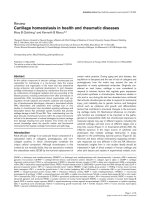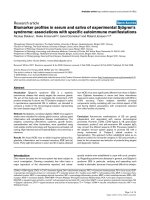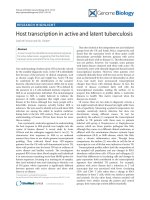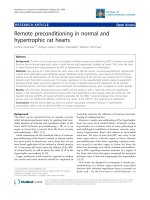Báo cáo y học: "Tibialis posterior in health and disease: a review of structure and function with specific reference to electromyographic studies" pot
Bạn đang xem bản rút gọn của tài liệu. Xem và tải ngay bản đầy đủ của tài liệu tại đây (1.42 MB, 8 trang )
BioMed Central
Page 1 of 8
(page number not for citation purposes)
Journal of Foot and Ankle Research
Open Access
Review
Tibialis posterior in health and disease: a review of structure and
function with specific reference to electromyographic studies
Ruth Semple*
1
, George S Murley
2,3
, James Woodburn
1,4
and
Deborah E Turner
1
Address:
1
Division of Podiatric Medicine and Surgery, School of Health, Glasgow Caledonian University, Glasgow, UK,
2
Department of Podiatry,
Faculty of Health Sciences, La Trobe University, Bundoora, Australia,
3
Musculoskeletal Research Centre, Faculty of Health Sciences, La Trobe
University, Bundoora, Australia and
4
HealthQWest Research Consortium, School of Health, Glasgow Caledonian University, Glasgow, UK
Email: Ruth Semple* - ; George S Murley - ; James Woodburn - ;
Deborah E Turner -
* Corresponding author
Abstract
Tibialis posterior has a vital role during gait as the primary dynamic stabiliser of the medial
longitudinal arch; however, the muscle and tendon are prone to dysfunction with several
conditions. We present an overview of tibialis posterior muscle and tendon anatomy with images
from cadaveric work on fresh frozen limbs and a review of current evidence that define normal and
abnormal tibialis posterior muscle activation during gait. A video is available that demonstrates
ultrasound guided intra-muscular insertion techniques for tibialis posterior electromyography.
Current electromyography literature indicates tibialis posterior intensity and timing during walking
is variable in healthy adults and has a disease-specific activation profile among different pathologies.
Flat-arched foot posture and tibialis posterior tendon dysfunction are associated with greater
tibialis posterior muscle activity during stance phase, compared to normal or healthy participants,
respectively. Cerebral palsy is associated with four potentially abnormal profiles during the entire
gait cycle; however it is unclear how these profiles are defined as these studies lack control groups
that characterise electromyographic activity from developmentally normal children. Intervention
studies show antipronation taping to significantly decrease tibialis posterior muscle activation
during walking compared to barefoot, although this research is based on only four participants.
However, other interventions such as foot orthoses and footwear do not appear to systematically
effect muscle activation during walking or running, respectively. This review highlights deficits in
current evidence and provides suggestions for the future research agenda.
Introduction
The tibialis posterior (TP) muscle has a vital role during
gait; via multiple insertion points into the tarsal bones it
acts as the primary dynamic stabiliser of the rearfoot and
medial longitudinal arch (MLA) [1,2]. The significance of
TP function is evident when the muscle and tendon are
dysfunctional, whereby stability of the foot is compro-
mised and is associated with a progressive flatfoot
deformity [3]. Prevalence data on TP tendon dysfunction
(TPTD) is lacking, however it has been recognised as a
painful and disabling condition affecting multiple patient
groups [4-6] and is frequently encountered in podiatric
Published: 19 August 2009
Journal of Foot and Ankle Research 2009, 2:24 doi:10.1186/1757-1146-2-24
Received: 18 May 2009
Accepted: 19 August 2009
This article is available from: />© 2009 Semple et al; licensee BioMed Central Ltd.
This is an Open Access article distributed under the terms of the Creative Commons Attribution License ( />),
which permits unrestricted use, distribution, and reproduction in any medium, provided the original work is properly cited.
Journal of Foot and Ankle Research 2009, 2:24 />Page 2 of 8
(page number not for citation purposes)
practice. Assessing the function of the TP muscle and ten-
don can be determined through careful clinical examina-
tion including techniques such as manual muscle testing
and the single heel rise test [7,8]. Clinical examination can
be supplemented with more specialist modalities includ-
ing muscle function magnetic resonance imaging (MRI)
[9], ultrasound [10], electromyography (EMG) [11,12]
and gait analysis [11,13,14]. The purpose of this paper is
to provide an overview of TP muscle and tendon anatomy
and to review current evidence that describes normal and
abnormal tibialis posterior muscle activation during gait
based on EMG.
Anatomy and Function
The TP muscle is contained within the deep posterior
compartment of the lower limb, arising from the adjacent
posterior surfaces of the tibia, fibula and interosseus
membrane (Figure 1). The tendon forms in the distal third
of the leg and changes direction to enter the foot where it
passes acutely behind the medial malleolus. In this region
the tendon flattens (Figure 2) and the tissue structure
changes; exhibiting an increased presence of fibrocartilage
[15,16] and an avascular region [17,18]. The tendon is
enclosed within a synovial sheath and is held firmly in
place by the flexor retinaculum which forms the roof of
the tarsal tunnel. The location of the TP tendon relative to
the axes of the subtalar and ankle joints facilitates inver-
sion and plantarflexion respectively. Tibialis posterior is
described as the most powerful supinator of the hindfoot
as a result of the large inverter moment arm acting on the
subtalar joint [19,20].
The TP tendon has multiple insertions within the foot,
dividing into three main components: (i) anterior; (ii)
middle; and (iii) posterior [21-23]. The anterior compo-
nent is the largest and extends to the navicular tuberosity;
it is reported to contain a fibrocartilaginous or bony sesa-
moid at this site. The sesamoid functions to provide a
pressure absorbing or gliding mechanism and was found
in 23% of 348 adult feet [24]. The middle and posterior
components extend to the remaining tarsal bones, the
middle three metatarsals and the flexor hallucis brevis
muscle. The complex anatomy of the insertion sites func-
tion to stabilise the MLA. Variations of the insertion have
Cross sectional anatomyFigure 1
Cross sectional anatomy. Cross section of cadaver limb,
taken 10 cm distal to the knee joint, indicating origin and
depth of the TP muscle and inaccessibility for surface EMG
investigation; tibia (T), fibula (F), tibialis posterior (TP) and
neurovascular bundle (NV).
Gross anatomy of retromalleolar regionFigure 2
Gross anatomy of retromalleolar region. Gross anat-
omy of retromalleolar region indicating flexor digitorum lon-
gus tendon (FDL), tibialis posterior tendon (TP), medial
malleolus (M) and tendo Achilles (TA). Small arrow indicates
rounded TP tendon proximally and large arrow indicates the
flattened area of tendon in retromalleolar region.
Journal of Foot and Ankle Research 2009, 2:24 />Page 3 of 8
(page number not for citation purposes)
been reported in the literature [21,22]; however the struc-
tural and functional significance of these variations are
unknown.
Tibialis posterior intramuscular EMG
The most common modality used to quantify TP muscle
activation is via EMG recorded with intramuscular elec-
trodes. The advantage of using EMG over other modalities
(such as MRI and ultrasound) is the ability to investigate
muscle activation simultaneously with dynamic weight-
bearing tasks such as walking. However, due to the deep
location of the muscle within the posterior compartment
of the leg, surface electrodes cannot record TP EMG activ-
ity without signal cross-talk from various superficial mus-
cles (Figure 1). Therefore, one disadvantage of assessing
TP with EMG is the requirement to use invasive intramus-
cular electrodes, which occasionally causes discomfort
and could alter normal walking.
There are two anatomical approaches for inserting intra-
muscular EMG electrodes into the TP muscle belly: (i) the
posterior-medial; and (ii) the anterior insertion. A video dem-
onstration of both approaches can be viewed via down-
loadable supplements (see Additional files 1 and 2). The
posterior insertion involves guiding the electrode posterior
to the tibia at a distance mid-way between the ankle and
tibial tuberosity. Penetration of the great saphenous vein
and posterior neurovascular bundle should be avoided.
The anterior insertion involves guiding the electrode
through tibialis anterior and the interosseous membrane
avoiding the deep anterior neurovascular bundle.
When choosing either the anterior or posterior insertion
approach, the two key issues to consider are safety and
dynamic stability of the electrode. Cadaveric and MRI
studies have shown the anterior approach provides a larger
safety window when inserting electrodes, as there is a
larger distance between osseous structures and neurovas-
cular bundles compared to the posterior approach [25,26].
Through piloting and preparation for previous TP EMG
work [12], we have found the anterior approach to be
unstable during walking. The most frequent problem is
retraction of the electrode tips from tibialis posterior
through the interosseous membrane into tibialis anterior.
Further research is required to quantify the success rate
and stability of both the anterior and posterior insertion
techniques under dynamic and non weight bearing condi-
tions.
Historically, intramuscular insertion procedures were
undertaken blindly without the aid of current imaging
techniques. Recent advances in imaging have improved
the accuracy of intramuscular electrode insertions with
the use of ultrasound to visualise the target zone and key
structures. Ultrasound imaging facilitates real-time obser-
vation of the insertion and identification of the neurovas-
cular bundle and anatomical variants. A recent
investigation of TP intramuscular electrode insertion, via
the posterior approach, was undertaken in five fresh fro-
zen cadaver limbs (RS) with the use of ultrasound guid-
ance. All five electrodes were correctly located in the
muscle belly of TP; figure 3 illustrates an example of one
dissected fresh frozen cadaver limb and the intramuscular
electrode.
Experience gained (GSM) in performing more than 150
intramuscular EMG electrode insertions into TP has led to
some important practical insights. Participants usually
describe low to mild discomfort during the insertion pro-
cedure with approximately 1 in 20 describing severe pain,
although this has not been quantified using a validated
pain scale. When participants experience severe pain, the
wires are removed and a second attempt at relocating new
wire electrodes is undertaken; rarely is a third attempt
required. During walking, participants usually describe
'mild' pain for the first couple of minutes, which fre-
quently subsides to 'no' or 'low' pain after this period.
Mild calf pain is often experienced for 24 hours following
the insertion procedure. There were no reported cases of
serious complications such as infection. The use of wire
electrodes is generally a safe and effective method of
investigating tibialis posterior EMG during walking.
Tibialis posterior EMG in health and disease
Current literature has characterised TP EMG during gait
among normal and pathological populations and with
various interventions including antipronation taping,
foot orthoses and athletic footwear. Figure 4 summarises
TP EMG profiles during walking among these popula-
tions.
Normative TP EMG during walking and running
Normative EMG for TP during walking is based on studies
with typically small sample sizes (ranging from 5 to 12)
and with participants' age ranging from 18 to 76 years
[5,11,12,27-29]. These studies have reported normal TP
EMG activity to occur during the stance phase of walking
in both young and older adults, with low-level activity in
late swing phase. Early studies reported varied periods of
TP EMG activity [27-29]; however, without the use of cur-
rent imaging techniques such as ultrasound, the accuracy
of intramuscular electrode placement is unclear. More
recent studies report TP activity as bi-phasic, with activity
occurring during contact and either midstance or propul-
sive phases of gait [5,11,12] (Figure 4a). Tibialis posterior
EMG is characterised by high between participant variabil-
ity among healthy adults during walking. Average TP EMG
amplitude during walking is estimated to be approxi-
Journal of Foot and Ankle Research 2009, 2:24 />Page 4 of 8
(page number not for citation purposes)
mately 20–25% (standard deviation 10–15%) when nor-
malised by a maximum isometric reference contraction
[12].
TP EMG activity during running was characterised by
Reber and colleagues [30] when they compared three run-
ning paces in fifteen recreational runners (mean age: 26
years). During the shortened period of stance phase
observed in running, TP displayed a single burst at all
three paces at an amplitude of approximately 70–80%
(normalised by what the authors described as a 'manual
muscle test'). For the fastest running speed, TP displayed
a second burst during mid-swing phase.
Overall, the availability of normative EMG for TP during
walking is based on relatively small sample sizes and is
limited to only adult and older adult participants. Despite
the absence of normative data, other studies have investi-
gated TP EMG activation with pathological conditions
including rheumatological and neurogenic diseases. With
the high variability seen in healthy people, it is difficult to
conclude whether the findings from studies investigating
abnormal muscle activity are meaningful.
Tibialis posterior tendon dysfunction
Tibialis posterior tendon dysfunction (TPTD) has been
reported as the most common cause of adult acquired flat-
foot [8,22,31,32] yet the aetiology of TPTD and the causal
relationship between flatfoot and TPTD remains unclear
[33-36]. Whilst numerous studies have investigated the
surgical management of this condition, including histo-
logical examination of the tendon, only one study has
investigated TP muscle function in TPTD [11]. This study
reported TP EMG in five female participants with acute
stage II TPTD (mean age: 69 years) compared to five
healthy adult volunteers (mean age: 27 years). They
reported significantly greater TP EMG amplitude in partic-
ipants with TPTD during the second half of stance phase
compared to the control group (Figure 4c). Significant dif-
ferences in muscle activation were also reported for other
lower limb muscles and it was postulated that these differ-
ences were an attempt to minimise the acquired flatfoot
deformity [11]. Whilst this study has provided important
preliminary evidence in terms of TP function; the findings
are limited by the small sample size and the results were
expressed relative to a maximum voluntary contraction
which may have been influenced by patient symptoms
[37].
Rheumatological disease
It has been suggested that certain rheumatological condi-
tions may predispose to TPTD including rheumatoid
arthritis (RA) [38,39] and seronegative inflammatory dis-
ease [4,40]. In patients with RA, TPTD has a reported prev-
alence between 13–64% dependant upon the diagnostic
criteria employed [39]. In an RA population, TPTD is fre-
quently associated with a pes plano valgus deformity yet
the relationship between the two remains ambiguous.
Some authors speculate that tenosynovitis and an attenu-
ated tendon is the cause of the valgus hindfoot [41] whilst
others hypothesise that subtalar and midfoot abnormali-
ties are more likely to be the cause [3,42]. Further theories
include stress related mechanical alterations resulting
from soft tissue changes and instability [42,43], whilst
others cite increased pronation forces as the cause and
report an association with genu valgum [5].
Despite the uncertainty regarding the pathogenesis of pes
plano valgus, gait analysis has been shown to improve our
understanding of this condition in RA [44,45]. Yet little is
known regarding TP function in this patient group with
only one paper investigating TP EMG in an RA population
with established disease (mean disease duration 25 years,
range 5–50 years in the valgus group). Utilising intramus-
cular EMG, Keenan and colleagues [5] demonstrated
increased TP EMG amplitude in ten patients with RA and
a valgus hindfoot alignment compared to seven control
subjects with RA and normal foot posture (Figure 4b). It
was hypothesised that the increased activity was an
attempt to support the collapsing MLA. Whilst these find-
ings indicate a similar trend to those of Ringleb and col-
leagues [11] in a TPTD population, further work is
required from a larger sample size.
Audit of placement of intramuscular electrodeFigure 3
Audit of placement of intramuscular electrode. Gross
anatomy of dissected limb with intramuscular electrode
inserted, indicating; flexor digitorum longus muscle/tendon
(FDL), tibialis posterior tendon (TP) and medial malleolus
(M). Large arrow indicates wire electrode protruding from
limb (3a and 3b) and small arrow indicates wire electrode
passing through the muscle belly of flexor digitorum longus
and into tibialis posterior (3b) with white paper to highlight
electrode.
Journal of Foot and Ankle Research 2009, 2:24 />Page 5 of 8
(page number not for citation purposes)
Tibialis posterior EMG activity during walking in health and diseaseFigure 4
Tibialis posterior EMG activity during walking in health and disease. Tibialis posterior EMG activity during walking in
health and disease – schematic estimates for ensemble-averaged tracings adapted from the respective studies. 0% and 100%
represents heel contact to ipsilateral heel contact. Vertical lines show average timing of temporal gait events. Time resolution
is approximated from original work to show a single gait cycle during walking. Amplitude characteristic are not scaled and can-
not be compared among different studies. Linear envelopes for figure D-G show estimated unfiltered/unrectified signals. NB.
Where multiple studies are available for each category, representation was based on the most recent work with the largest
sample size.
Journal of Foot and Ankle Research 2009, 2:24 />Page 6 of 8
(page number not for citation purposes)
Neurological disease with focus on cerebral palsy
TP muscle dysfunction is likely to occur with many neuro-
genic conditions, however little is known about how
many of these conditions affect TP muscle activity during
walking. Cerebral palsy is one neurogenic condition
where TP muscle activation has been investigated as part
of several laboratory-based clinical assessments [46-53].
Cerebral palsy frequently causes varus or equinovarus foot
deformity which can be painful and disabling, often
resulting in surgical correction.
Intramuscular electrodes have been utilised to assess TP
muscle activation among infants, children and young
adult patients (age range: 4–24 years) – often as part of a
surgical planning procedure (Figure 4d–g) [46-50].
Among these studies, TP muscle dysfunction is reported to
include; (i) an active 'out of phase burst' (i.e. greater activ-
ity during swing phase compared to stance phase), and
(ii) a continuous burst throughout the gait cycle [48]. TP
dysfunction has also been reported as 'overactivity in
swing phase' – characterised by a period of low-level TP
EMG activity prior to heel contact [50,51]. However, more
recent EMG data from a young-adult population indicates
that low-level pre-heel strike activation of TP is normal
[12]. Of the twenty-five cases presented by Scott and Scar-
borough [50], fifteen were classified as having 'overactiv-
ity in swing phase' and eight of these cases displayed
'phasic' (i.e. normal) tibialis anterior activity. Therefore, it
appears likely that eight of the twenty-five cases referred
for split TP transfer surgery actually displayed normal tibi-
alis posterior and tibialis anterior EMG during walking. It
is noted these patients also displayed continuous gastroc-
nemius overactivity, which may provide further explana-
tion regarding the cause of the varus or equinovarus
deformities.
A further study by Michlitsch and colleagues [49] involved
a retrospective study from pre-operative data recorded
from seventy-eight patients assessed over an 11-year
period. They reported approximately 1/3 of varus deform-
ities linked with cerebral palsy are associated with TP
alone and a further 1/3 are associated with abnormal
activity from a combination of abnormal TP and tibialis
anterior muscle dysfunction. One subtype of TP dysfunc-
tion was described as 'under-activity' characterised by a
single burst during contact period. Again, more recent
EMG data from a young adult population shows a single
burst from TP occurring during only contact period is nor-
mal [12].
While there is consensus among these investigations that
both TP and tibialis anterior contribute to varus or equi-
novarus foot deformity with cerebral palsy, one major
shortcoming is that none of these investigations have
directly compared TP EMG profiles to age matched con-
trol groups within the same study. This may account for
the different and potentially invalid classifications among
these studies of TP dysfunction with cerebral palsy. Fur-
ther normative EMG from TP is required to inform studies
investigating pathological sub-types of TP muscle dys-
function in children with cerebral palsy.
Tibialis posterior response to intervention
Foot orthoses, antipronation taping and footwear
Only one study has investigated the effect of foot orthoses
on TP activation during walking [54] despite foot orthoses
being the mainstay of conservative intervention for early-
stage TPTD. Intramuscular TP activity was recorded from
five participants (age range: 25–69 years) with flat-arched
foot posture using three different styles of foot orthoses.
This study found no systematic changes in TP EMG with
the three types of foot orthoses. A similar result was
reported for another study investigating three styles of
athletic footwear, each with a custom-made midsole
aimed at inducing foot pronation and supination during
running [9]. This study investigated TP EMG amplitude
and temporal characteristics in 10 males (average age: 27
years), however no significant changes were reported for
TP EMG among the three shoe styles.
These findings contrast another investigation on the effect
of anti-pronation taping on TP EMG during walking in
four young- to middle-aged adults with flat-arched feet
[55]. Franettovich and colleagues [55] reported a system-
atic decrease in average and peak TP EMG amplitude dur-
ing the midstance/propulsive phases of between 21–45%,
compared to baseline (barefoot walking). Conservative
physical therapies such as foot orthoses, antipronation
taping and footwear are considered to perform an impor-
tant function in altering TP muscle activity during walk-
ing, particularly with individuals that have flat-arched
foot posture. While there is some preliminary evidence
regarding the effect of antipronation tape on TP EMG
muscle function [55], the available literature comprises
only one investigation based on four participants.
Conclusion and future recommendations
A number of studies investigating TP EMG activation in
health and disease have been undertaken with small sam-
ple sizes providing preliminary evidence of either abnor-
mal function or response to intervention. Accordingly,
further EMG studies, recruiting larger sample sizes and
representation from the younger and older populations,
are required to investigate both the effect of interventions
on TP muscle activity and to establish a reference data-
base. Whilst it has been recognised that TP plays a vital
role during gait, further work is required to more fully
understand the role of TP in the development of pathol-
ogy and in disease-specific populations including RA, cer-
ebral palsy and TPTD.
Journal of Foot and Ankle Research 2009, 2:24 />Page 7 of 8
(page number not for citation purposes)
In summary, TP EMG remains a specialist investigation
undertaken in relatively few centres internationally; how-
ever, this technique has multiple applications both in
research and in planning interventions and evaluating
outcomes. Recent advances in technology, including
imaging, represent an opportunity to employ this tech-
nique more frequently and advance our understanding in
a variety of areas.
Competing interests
The authors declare that they have no competing interests.
Authors' contributions
DET and JW conceived the idea for the review, RS and
GSM drafted the manuscript and the figures, GSM pre-
pared the video supplement, JW and DET critically revised
the manuscript. All authors read and approved the final
manuscript.
Additional material
Acknowledgements
RS and DET are funded by the Arthritis Research Campaign, grant refer-
ence numbers 18381 and 17832 respectively. We thank Matthew Cotchett
(La Trobe University) and Jason De Luca (Southern Cross Medical Imaging)
for assisting with production of the video supplement.
References
1. Basmajian J, Stecko G: The role of muscles in support of the
arch of the foot. J Bone Joint Surg Am 1963, 45:1184-1190.
2. Kaye RA, Jahss MH: Tibialis posterior: a review of anatomy and
biomechanics in relation to support of the medial longitudi-
nal arch. Foot Ankle 1991, 11:244.
3. Myerson M: Adult acquired flatfoot deformity: treatment of
dysfunction of the posterior tibial tendon. Instr Course Lect
1997, 46:393-405.
4. Myerson M, Solomon G, Shereff M: Posterior tibial tendon dys-
function: its association with seronegative inflammatory dis-
ease. Foot Ankle 1989, 9:219-225.
5. Keenan M, Peabody T, Gronley J, Perry J: Valgus deformities of
the feet and characteristics of gait in patients who have rheu-
matoid arthritis. J Bone Joint Surg Am 1991, 73(2):237-247.
6. Holmes GJ, Mann R: Possible epidemiological factors associ-
ated with rupture of the posterior tibial tendon. Foot Ankle
1992, 13:70-9.
7. Johnson K, Strom D: Tibialis posterior tendon dysfunction. Clin
Orthop Relat Res 1989, 239:196-206.
8. Kohls-Gatzoulis J, Angel J, Singh D, Haddad F, Livingstone J, Berry G:
Tibialis posterior dysfunction: a common and treatable
cause of adult acquired flatfoot. BMJ 2004, 329:1328-1333.
9. O'Connor K, Price T, Hamill J: Examination of extrinsic foot
muscles during running using mfMRI and EMG. J Electromyogr
Kinesiol 2006, 16:522-530.
10. Valderrabano V, Hintermann B, Wischer T, Fuhr P, Dick W: Recov-
ery of the posterior tibial muscle after late reconstruction
following tendon rupture. Foot Ankle Int 2004, 25:85-95.
11. Ringleb S, Kavros S, Kotajarvi B, Hansen D, Kitaoka H, Kaufman K:
Changes in gait associated with acute stage II posterior tibial
tendon dysfunction. Gait Posture
2007, 25:555-64.
12. Murley G, Buldt A, Trump P, Wickham J: Tibialis posterior EMG
activity during barefoot walking in people with neutral foot
posture. J Electromyogr Kinesiol 2009, 19:e69-e77.
13. Rattanaprasert U, Smith R, Sullivan M, Gilleard W: Three-dimen-
sional kinematics of the forefoot, rearfoot, and leg without
the function of tibialis posterior in comparison with normals
during stance phase of walking. Clin Biomech 1999, 14:14-23.
14. Ness M, Long J, Marks R, Harris G: Foot and ankle kinematics in
patients with posterior tibial tendon dysfunction. Gait Posture
2008, 27:331.
15. Petersen W, Hohmann G, Pufe T, Tsokos M, Zantop T, Paulsen F, Till-
man B: Structure of the human tibialis posterior tendon. Arch
Orthop Trauma Surg 2004, 124:237-242.
16. Benjamin M, Qin S, Ralphs JR: Fibrocartilage associated with
human tendons and their pulleys. J Anat 1995, 187:625-633.
17. Frey C, Shereff M, Greenidge N: Vascularity of the posterior tib-
ial tendon. J Bone Joint Surg Am 1990, 72:884-888.
18. Petersen W, Hohmann G, Stein V, Tillmann B: The blood supply of
the posterior tibial tendon. J Bone Joint Surg Br 2002, 84:141-144.
19. Perry J: Gait analysis: normal and pathological function. SLACK
Incorporated 1992.
20. Hintermann B, Nigg BM, Sommer C: Foot movement and tendon
excursion: an in vitro study. Foot Ankle 1994, 15:386.
21. Martin B: Observations on the muscles and tendons of the
medial aspect of the sole of the foot. J Anat 1964, 98:437-453.
22. Bloome D, Marymont J, Varner K: Variations on the insertion of
the posterior tibialis tendon: a cadaveric study. Foot Ankle Int
2003, 24:780.
23. Sarrafian S:
Anatomy of the foot and ankle: descriptive, topo-
graphic, functional. 2nd edition. Philadelphia: Lippincott; 1993.
24. Agur A, Dalley A: Grant's atlas of anatomy. Lippincott Williams
& Wilkins; 2008.
25. Lee H, Bach J, DeLisa J: Needle electrode insertion into tibialis
posterior: a new approach. Am J Phys Med Rehabil 1990, 69:126.
26. Yang S, Lee S, Kwon H: Needle electrode insertion into the tibi-
alis posterior: a comparison of the anterior and posterior
approaches. Arch Phys Med Rehabil 2008, 89:1816.
27. Sutherland D: An electromyographic study of the plantar flex-
ors of the ankle in normal walking on the level. J Bone Joint Surg
Am 1966, 48:66-71.
28. Ambagtsheer JB: The function of the muscles of the lower leg
in relation to movements of the tarsus. Acta Orthop Scand Suppl
1978, 172:1-196.
29. Gray EG, Basmajian JV: Electromyography and cinematography
of leg and foot ("normal" and flat) during walking. Anat Rec
1968, 161:1-15.
30. Reber L, Perry J, Pink M: Muscular control of the ankle in run-
ning. Am J Sports Med 1993, 21:805-810.
31. Geideman W, Johnson J: Posterior tibial tendon dysfunction. J
Orthop Sports Phys Ther 2000, 30:68-77.
32. Uchiyama E, Kitaoka H, Fujii T, Luo Z, Momose T, Berglund L, An KN:
Gliding resistance of the posterior tibial tendon. Foot Ankle Int
2006, 27:723-727.
33. Funk D, Cass J, Johnson K: Acquired adult flat foot secondary to
posterior tibial-tendon pathology. J Bone Joint Surg Am 1986,
68:95-102.
34. Mosier S, Pomeroy G, Manoli A2: Pathoanatomy and etiology of
posterior tibial tendon dysfunction. Clin Orthop Rel Res 1999,
365:12-22.
Additional file 1
Posterior approach. A video demonstration of the posterior approach of
intramuscular electrode insertion. Additional files 1 and 2 can only be
viewed using the latest version of QuickTime Player which can be down-
loaded via the following link: />Click here for file
[ />1146-2-24-S1.mov]
Additional file 2
Anterior approach. A video demonstration of the anterior approach of
intramuscular electrode insertion.
Click here for file
[ />1146-2-24-S2.mov]
Publish with Bio Med Central and every
scientist can read your work free of charge
"BioMed Central will be the most significant development for
disseminating the results of biomedical research in our lifetime."
Sir Paul Nurse, Cancer Research UK
Your research papers will be:
available free of charge to the entire biomedical community
peer reviewed and published immediately upon acceptance
cited in PubMed and archived on PubMed Central
yours — you keep the copyright
Submit your manuscript here:
/>BioMedcentral
Journal of Foot and Ankle Research 2009, 2:24 />Page 8 of 8
(page number not for citation purposes)
35. Pomeroy G, Pike R, Beals T, Manoli A: Acquired flatfoot in adults
due to dysfunction of the posterior tibial tendon. J Bone Joint
Surg Am 1999, 81:1173-82.
36. Yeap J, Singh D, Birch R: Tibialis posterior tendon dysfunction:
a primary or secondary problem? Foot Ankle Int 2001, 22:51-5.
37. Murley G, Landorf K, Menz H, Bird A: Effect of foot posture, foot
orthoses and footwear on lower limb muscle activity during
walking and running: A systematic review. Gait Posture 2009,
29:172-187.
38. Downey D, Simkin P, Mack L, Richardson M, Kilcoyne R, Hansen S:
Tibialis posterior tendon rupture: a cause of rheumatoid flat
foot. Arthritis Rheum 1988, 31:441-446.
39. Michelson J, Easley M, Wigley FM, Hellmann D: Posterior tibial ten-
don dysfunction in rheumatoid arthritis. Foot Ankle Int 1995,
16:156-161.
40. Jahss MH: Foot and ankle pain resulting from rheumatic con-
ditions. Curr Opin Rheumatol 1992, 4:233-240.
41. Masterson E, Mulcahy D, McElwain J, McInerney D: The planoval-
gus rheumatoid foot-is tibialis posterior tendon rupture a
factor? Br J Rheumatol 1995, 34:645-646.
42. Spiegel T, Spiegel J: Rheumatoid arthritis in the foot and ankle
– diagnosis, pathology, and treatment. The relationship
between foot and ankle deformity and disease duration in 50
patients. Foot Ankle 1982, 2:318-324.
43. Woodburn J, Cornwall M, Soames R, Helliwell P: Selectively atten-
uating soft tissues close to sites of inflammation in the per-
italar region of patients with rheumatoid arthritis leads to
development of pes planovalgus. J Rheumatol 2005, 32:268-274.
44. Turner D, Woodburn J, Helliwell P, Cornwall M, Emery P: Pes
planovalgus in RA: a descriptive and analytical study of foot
function determined by gait analysis. Musculoskeletal Care 2003,
1:21-33.
45. Woodburn J, Helliwell PS, Barker S: Three-dimensional kinemat-
ics at the ankle joint complex in rheumatoid arthritis
patients with painful valgus deformity of the rearfoot. Rheu-
matology 2002, 41:1406-12.
46. Barto PS, Supinski RS, Skinner SR: Dynamic EMG findings in varus
hindfoot deformity and spastic cerebral palsy. Dev Med Child
Neurol 1984, 26:88-93.
47. Perry J, Hoffer MM: Preoperative and postoperative dynamic
electromyography as an aid in planning tendon transfers in
children with cerebral palsy. J Bone Joint Surg Am 1977, 59:531-7.
48. Wills C, Hoffer M, Perry J: A comparison of foot-switch and
EMG analysis of varus deformities of the feet of children with
cerebral palsy. Dev Med Child Neurol 1988, 30:227-31.
49. Michlitsch MG, Rethlefsen SA, Kay RM: The contributions of ante-
rior and posterior tibialis dysfunction to varus foot deformity
in patients with cerebral palsy. J Bone Joint Surg Am 2006,
88:1764-8.
50. Scott AC, Scarborough N: The use of dynamic EMG in predict-
ing the outcome of split posterior tibial tendon transfers in
spastic hemiplegia. J Pediatr Orthop 2006, 26:777-80.
51. Brunt D, Scarborough N: Ankle muscle activity during gait in
children with cerebral palsy and equinovarus deformity. Arch
Phys Med Rehabil 1988, 69:115-117.
52. Close J, Todd F: The phasic activity of the muscles of the lower
extremity and the effect of tendon transfer. J Bone Joint Surg
Am 1959, 41:189-235.
53. Green N, Griffin P, Shiavi R: Split posterior tibial-tendon trans-
fer in spastic cerebral palsy. J Bone Joint Surg Am 1983,
65:748-754.
54. Stacoff A, Quervain I, Dettwyler M, Wolf P, List R, Ukelo T, Stussi E:
Biomechanical effects of foot orthoses during walking. Foot
2007, 17:143-153.
55. Franettovich M, Chapman A, Vicenzino B: Tape that increases
medial longitudinal arch height also reduces leg muscle
activity: a preliminary study. Med Sci Sports Exerc 2008,
40:593-600.
